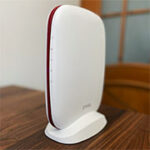The Zyxel SCR 50AXE marks the manufacturer’s move towards the larger scale implementation of the WiFi 6E features into its networking devices, and, while initially a bit shy with just a couple of wireless access points, this time, it’s a security router.
| Zyxel SCR 50AXE | |
|---|---|
| Zyxel.com | Check Product |
The Zyxel SCR 50AXE is Cloud-managed, so it is supposed to work with other Nebula devices and the targeted audience consists of small businesses and I suppose tech enthusiasts, especially those that want to try their hands at the new 6GHz radio. What’s interesting is that the Zyxel SCR 50AXE is limited by Gigabit ports, all of them, so the point of the router is not really to push the WiFi speed to its limits, but to provide a very comprehensive set of security features for a smaller office (the 1GB RAM should help in this regard). So, the 6GHz is more of a bonus in case some client device will actually be compatible with it.
And it’s a bit of a mess considering that Microsoft forces its users to update to the Windows 11 version in order to make use of a WiFi 6E adapter, and we both know that both the software and the hardware upgrade momentum in the corporate world does not keep up with the current two-year cycle for the release of a new WiFi standard. Of course, a start-ups or tech enthusiasts will want to make use of the far cleaner performance of the 6GHz and the Zyxel SCR 50AXE should deliver.
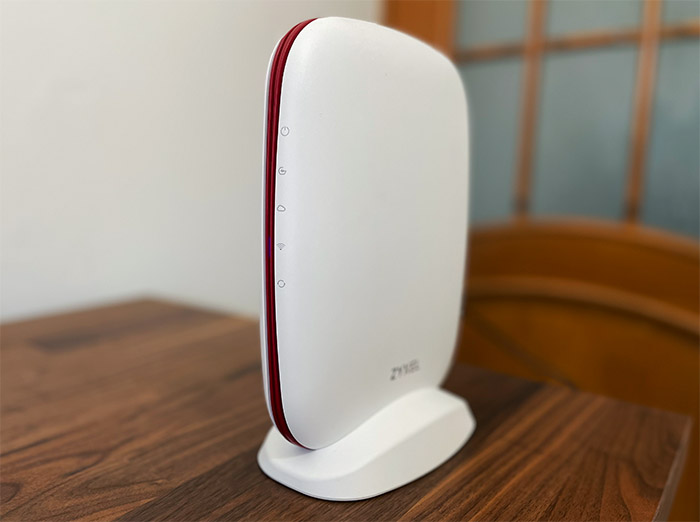
That being said, let’s put the security-focused wireless router to the test to see how well it performs and to confirm whether the hype around the WiFi 6E is warranted.
Note: Like I mentioned before, be aware that the Zyxel SCR 50AXE is Cloud-based, so it can only be monitored and configured via the Nebula management platform.
IMPORTANT UPDATE 05.27.2023: Make sure to update the security router to the latest firmware because Zyxel has fixed some significant issues that I have experienced when testing the device.
UPDATE 07.27.2023: I can now set the 5GHz radio band to use the 160MHz channel width, so I retested the router to show the new data.
Design and Build Quality
The Zyxel SCR 50AXE was not designed to fit into a rack, so it did not follow the look of the other security gateways from Zyxel. Instead, it looks very similar to the mesh nodes of the Multy X mesh system. The case is made of plastic, has rounded corners and it’s covered by a white matte finish on the sides, but with a red frame cutting the device in the middle. In a way, it’s kind of a retro look, especially since you get a stand to keep the wireless router upwards, thus covering less space from the desk and I saw no silicone feet to put the device on its side.
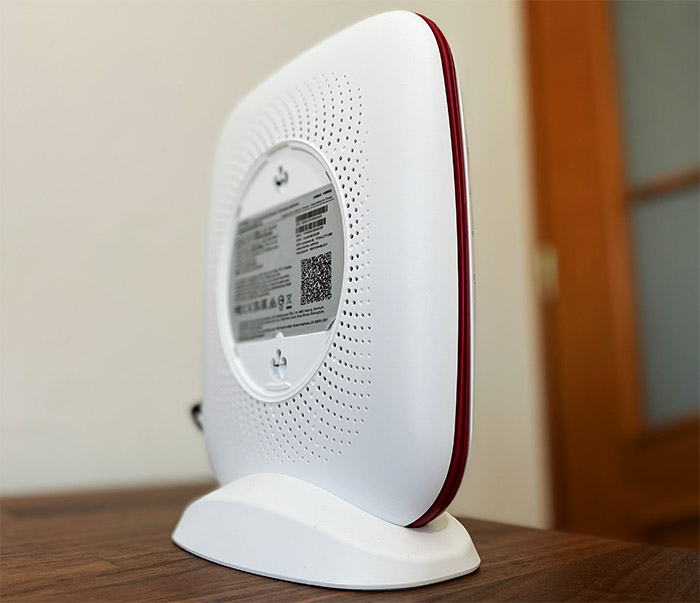
The good news is that there are two dedicated mounting holes if you decide to install the Zyxel SCR 50AXE on the wall – that area can be hidden by a plastic cover provided by Zyxel, so it retains its minimalist look. The device measures 9.5 x 7.0 x 2.1 (24.2 x 17.8 x 5.4cm) and it’s worth mentioning that the stand attaches magnetically to the bottom of the router – the case does creak when squeezed. Obviously, this type of design does not support external antennas, so, similarly to the ceiling-mount APs, the antennas are inside the case.
I have seen that Zyxel has added numerous puncture holes on one side of the SCR 50AXE and there are a few very narrow ventilation holes at the top and bottom (within the red frame). But is that enough to ensure a proper internal temperature? The SoC and WiFi chips have gotten insanely power efficient, so it does seem that the space inside the case + the ventilation holes are enough to keep the temperature low. I have added a thermal photo for peace of mind.
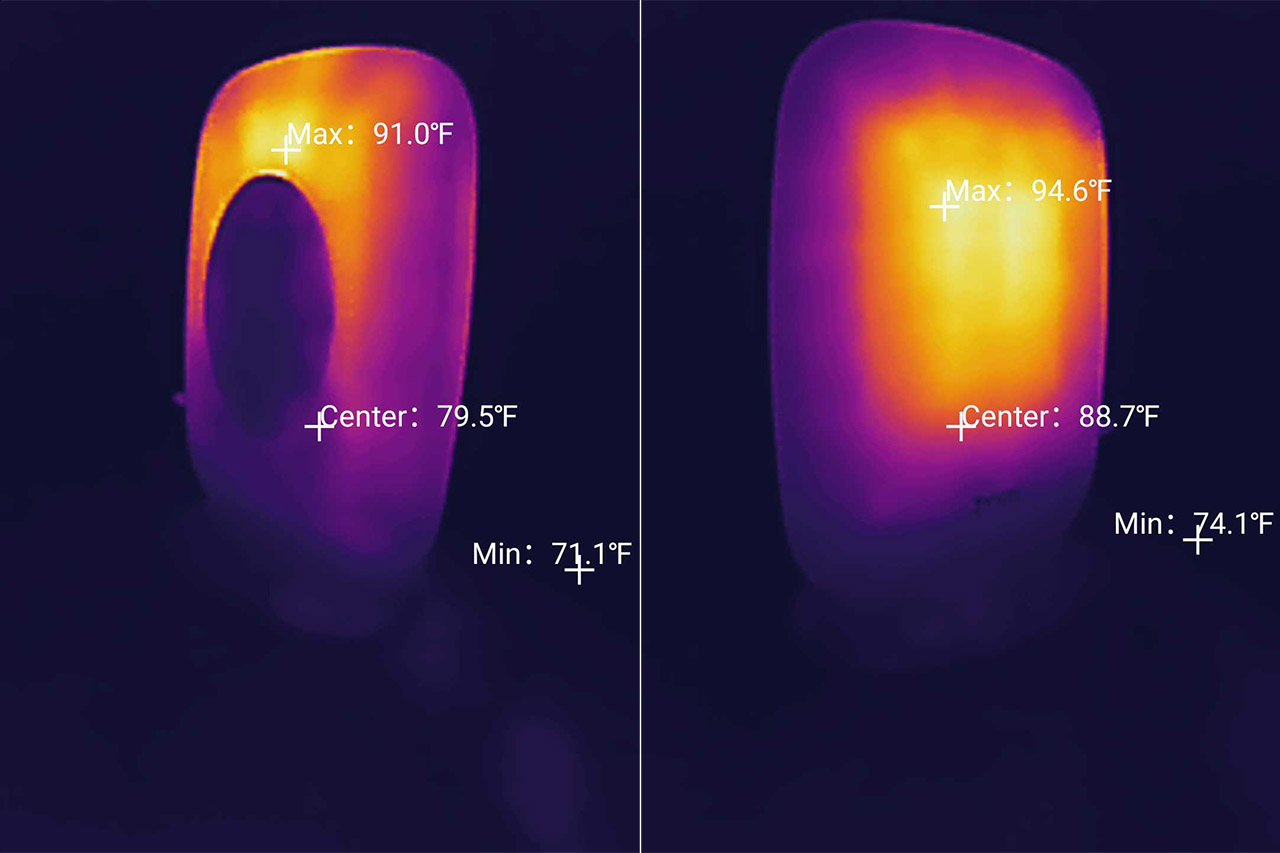
Zyxel has added the array of LEDs on the front of the wireless router, embedded within the red plastic frame and from the top, there’s the Power LED, the WAN/Internet LED (with a very strange icon) followed by the Cloud indicator.
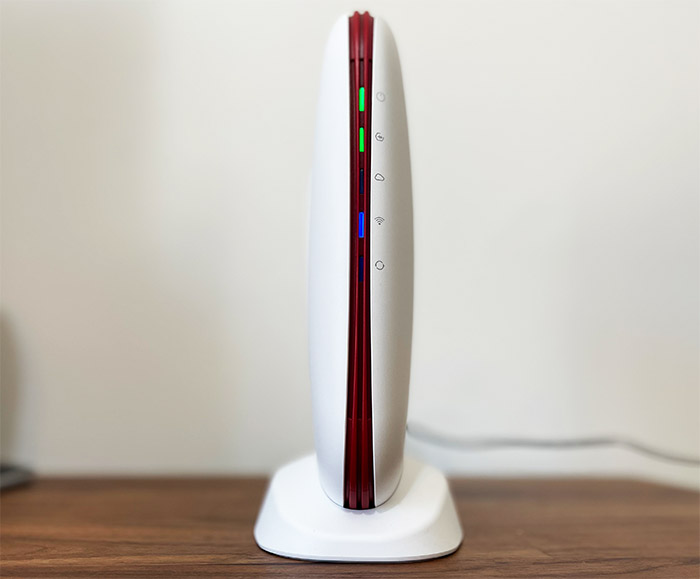
A bit lower, you can see a single LED for the WiFi (one for three..) and the last LED is for the WPS function. I initially thought it was for when the Reset button is pressed, but apparently, next to the recessed Reset button, there’s the WPS switch without an icon, so it’s easy to confuse the user. You can also check out whether you should still use WPS or if it’s better to rely on other means of connecting devices to the network.
Underneath the aforementioned couple of buttons, there’s the dedicated ports area where you can see the Gigabit Ethernet WAN port, along with the four LAN ports, also Gigabit and the Power port. The 6GHz and Gigabit will raise some eyebrows, but it was a cost-conscious decision, so let’s hope that the Zyxel SCR 50AXE pushes close-to-Gigabit WiFi over a far larger area than the WiFi 6 and 5 routers in the same price category.
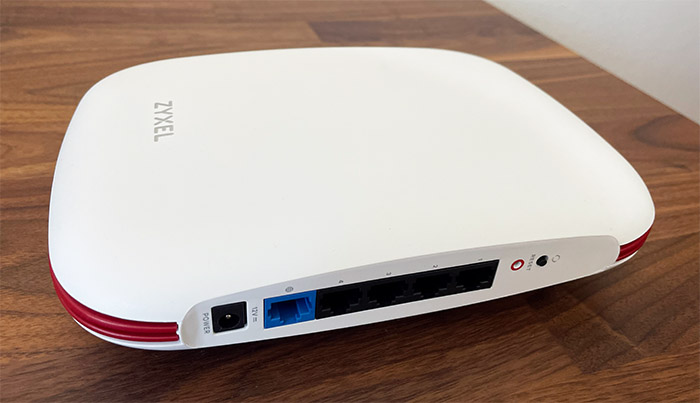
Internal Hardware (Zyxel SCR 50AXE Teardown)
If you thought there are no screws around the case, Zyxel has included four hidden underneath the label. I don’t think removing this label will cause the warranty to be voided, but still keep in mind that the manufacturers don’t like it when you’re prying open the case while the device is still in warranty, so tread carefully. That being said, after removing the screws and detaching the plastic case, I could see that there is lots of room for the heat to dissipate and there were two plastic arches as extra protection for the PCB (against possible shocks or were those creaks a lot worse before?).
All the antennas sit at the top of the Zyxel SCR 50AXE and I could already identify the 256MB of NAN flash memory from Winbond (25N02KWZEIR). I saw that there was a heatsink covering the main chip, so I decided to flip the board upside down and remove the screws that held it. There were no screws, the heatsink was soldered – just great. I still managed to identify the WiFi chipsets, which eventually lead to the identification of the SoC. We are dealing with a dual-core Qualcomm IPQ5018 (ARM Cortex-A53 processor clocked at 1GHz) and, while the exact RAM brand remains incognito, we do know that the total amount is 1GB.
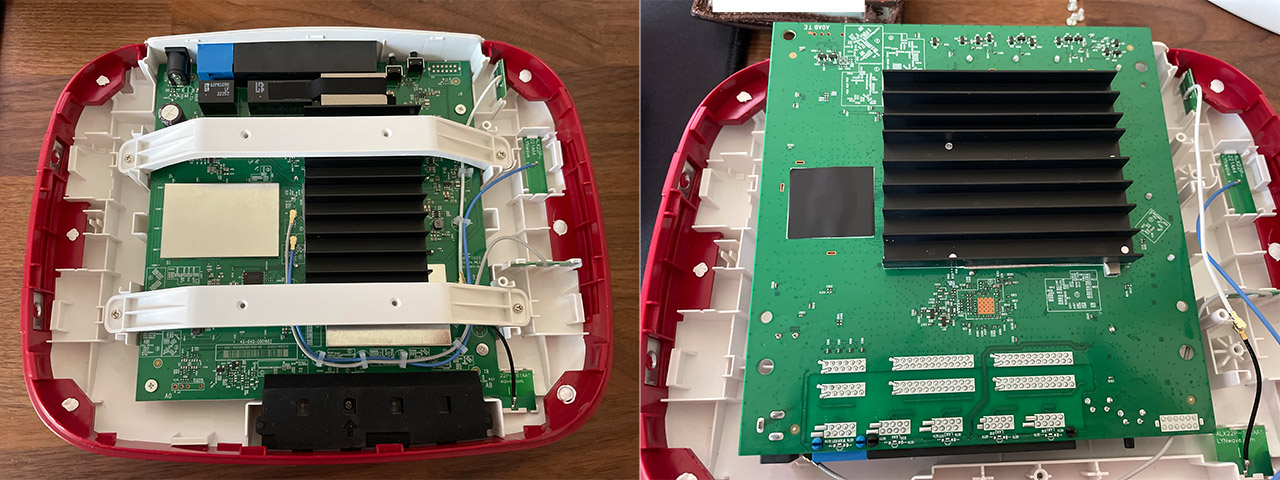
Also, I couldn’t identify the switch chip. That being said, for WiFi, the Zyxel SCR 50AXE uses a Qualcomm QCN6122 802.11ax 2×2:2 + 2x Sy6525DK front-end modules for the 6GHz radio and the Qualcomm QCN6102 802.11b/g/n/ax along with 2x K495 504HT 12130 front-end modules for the 5GHz. I am fairly sure that the Zyxel SCR 50AXE uses the same Qualcomm QCN6122 chip for the 5GHz radio band as well, so I was very curios whether they can be used at the same time, or in turn, as it was the case with the Zyxel NWA220AX-6E (especially since both are built on the same platform and use the exact same SoC).
Thankfully, it’s not and I could see all three radio bands at the same time, so it is a true tri-band wireless router. Lastly, for those that are interested in the theoretical maximum data rates, know that on the 6GHz, it’s 2,402Mbps, as well as on the 5GHz, also 2,402Mbps, while on the 2.4GHz, it’s 574Mbps. In total, it amounts to the advertised AXE5400.
Zyxel SCR 50AXE vs NWA220AX-6E vs EnGenius ECW336
| Zyxel SCR 50AXE | Zyxel NWA220AX-6E | EnGenius ECW336 | |
| CPU | dual-core 1GHz Qualcomm IPQ5018 | dual-core 1GHz Qualcomm IPQ5018 | quad-core 2.2GHz Qualcomm IPQ8072A |
| RAM | 1GB | 1GB (2x) Micron 2CP75 D9SGQ | 1GB Samsung (SEC216 K4A8G16) |
| Storage | 256MB Winbond (25N02KWZEIR) | 512MB Winbond 25N02JWZEIF + 8MB Winbond 25Q64JWSIQ | 256MB Winbond (W29N02GZBIBA) |
| Switch | Qualcomm QCA8337 | Qualcomm QCA8081 | Marvell AQrate AQR114C GEN4 PHY |
| 6GHz Radio | Qualcomm QCN6122 802.11ax 2×2:2 | Qualcomm QCN9024 802.11ax 4×4:4 | Qualcomm QCN9024 802.11ax 4×4:4 |
| 5GHz Radio | Qualcomm QCN6102 802.11ax 2×2:2 | Qualcomm QCN9024 802.11a/n/ac/ax 4×4:4 | Qualcomm Atheros IPQ8072A (QCN5054) 802.11a/n/ac/ax 4×4:4 |
| 2.4GHz Radio | Qualcomm Atheros IPQ5018 802.11b/g/n/ax 2×2 | Qualcomm Atheros IPQ5018 802.11b/g/n/ax 2×2 | Qualcomm QCN6102 802.11b/g/n/ax |
The WiFi Features
The most important WiFi feature of the Zyxel SCR 50AXE is the support for the 6GHz radio band that will behave miles better than the 5GHz which, although wider than the 2.4GHz radio, it has become overcrowded and very much prone to interference. We don’t even need to mention the 2.4GHz radio because at this point, its role has been reduced towards keeping low-power IoT devices connected to their mother servers. And yes, you can use the 160MHz in a more reliable way since you should experience no channel interference with other APs for two reasons.
One, there are no wireless access points that support this radio band in your area and it will take years before you encounter a few; the second reason is because you gain far more non-overlapping channels to choose from. At the moment, the only issue is that there are very, very few compatible client devices on the market and the vast majority of the older devices aren’t compatible – yes, the 6GHz is not backwards compatible. I saw that the Zyxel SCR 50AXE should does support the 160MHz channel bandwidth on the 5GHz as well (it says so in the Nebula controller), but when I tried to set it up, I kept getting a weird error. and, while before it did not function, it has been enabled with the latest update.
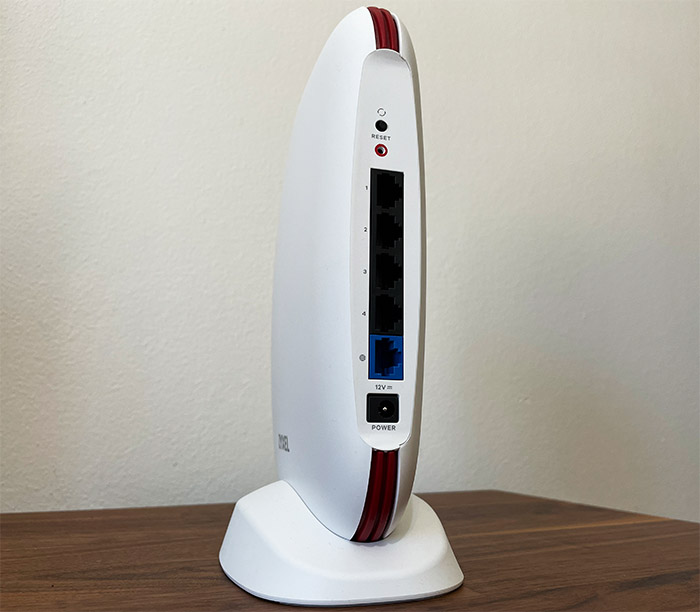
I assumed that maybe the 5GHz or the 6GHz can be used one at a time on the 160MHz, which I guess could make sense, but even after disabling the 6GHz radio, it still didn’t work. This is one bug that Zyxel needs ironed out. I spoke with Zyxel and they have confirmed that there is indeed a problem which they have promised to fix by June 2023.
Since there is support for the 802.11ax standard, I assume that the wireless router can make use of the OFDMA (I saw no setting to enable it) which should help in a very crowded area with lots of access points. Otherwise, you won’t really see it in action and that’s assuming that you have compatible client devices.
Same as MU-MIMO and Beamforming which also need compatibility, otherwise they’re pretty much unused. Furthermore, I could enable 802.11k/v Assisted roaming, as well as 802.11r Fast Roaming in case you want to use the wireless router along with other Zyxel access points and prefer to give the user a seamless roaming experience between devices.
The Wireless Test (6GHz)
The Zyxel SCR 50AXE broadcasts all three radio signals at the same time, so I could connect a couple of client device immediately, a computer equipped with an AX200 WiFi 6 adapter and another PC that was equipped with a TP-Link AXE5400 WiFi 6E adapter.
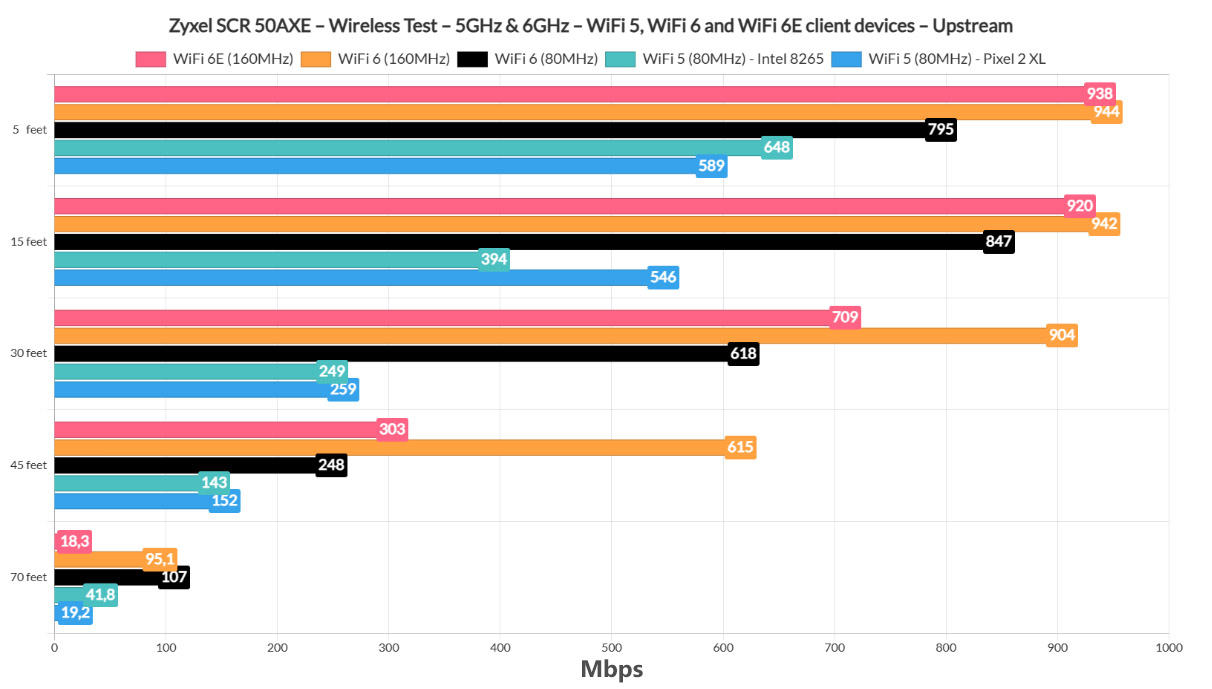
And I would have liked to connect the two WiFi 5 client devices, but I set the radios to operate in 802.11ax mode only, to check how well the router performs with perfectly compatible client devices. Also, I chose a separate computer for the WiFi 6E because I could only connect to a Linux machine, and that’s because Microsoft has been gatekeeping the access to WiFi 6E networks only for Windows 11 – there is no chance I’m upgrading to that ad-filled excuse of an operating system.
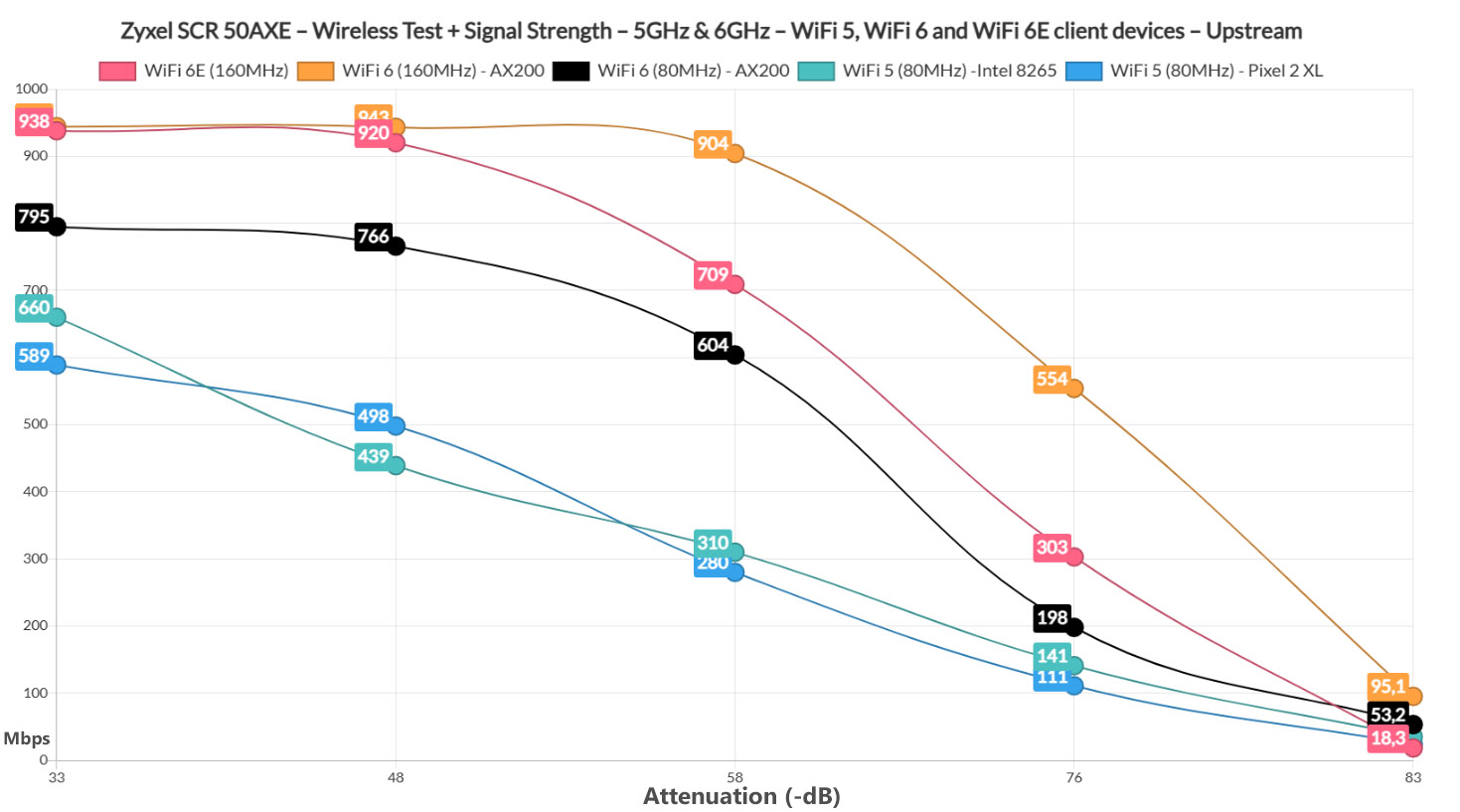
Not that Windows 10 is that much better, but I digress. I made sure that the server was connected to the router via cable and then I connected the Linux machine to the 6GHz SSID (160MHz) – the Zyxel SCR 50AXE did initially refuse to enable the LAN ports, but I dedicated an entire section to the bugs I encountered. That being said, I could see that upstream, at 5 feet, the average throughput was 938Mbps, while downstream, it was 799Mbps (-33dB attenuation).
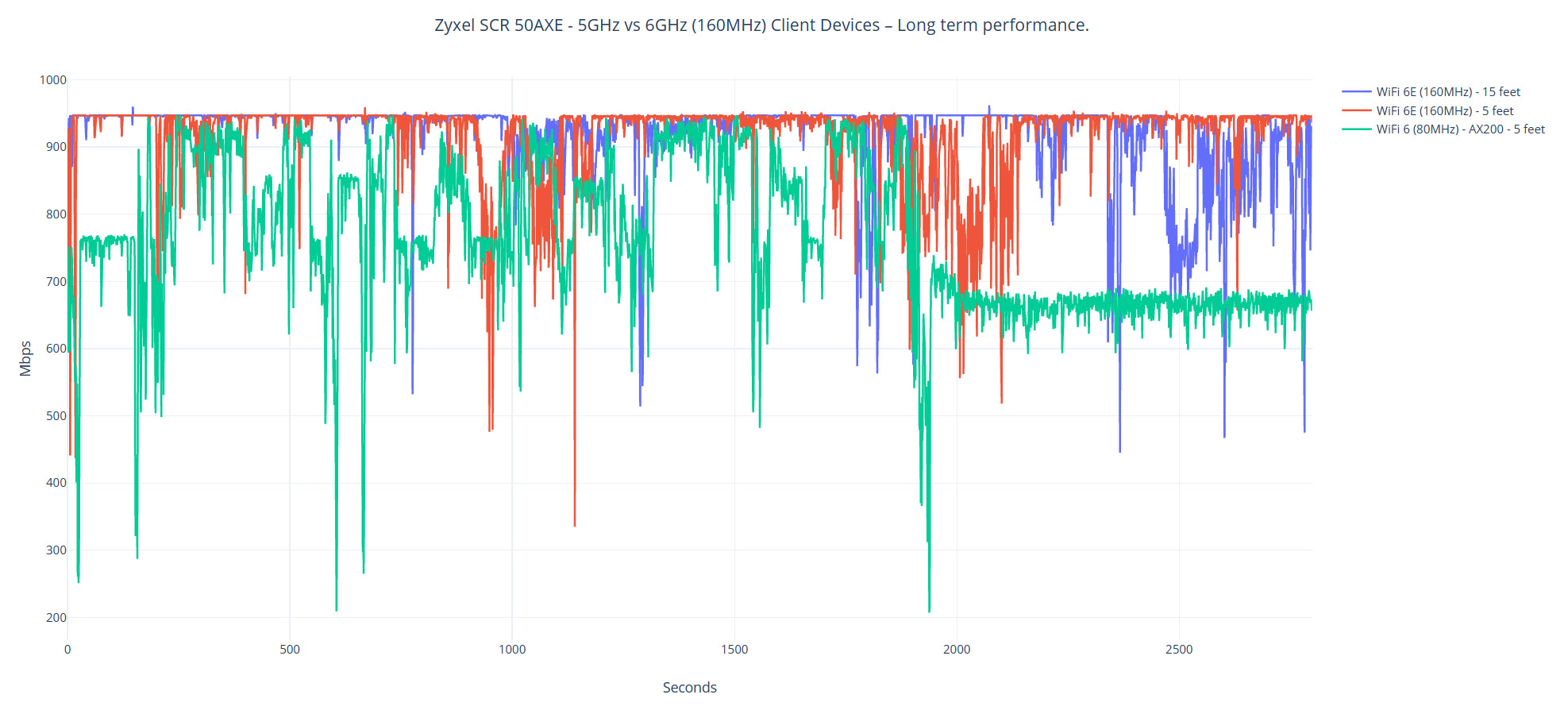
I am sure that it could have easily gone above the Gigabit limit, but we have no multi-Gigabit ports available to test this claim. The performance remained solid even at 30 feet (-58 attenuation), where upstream, I saw an average of 709Mbps and downstream, it was 673Mbps. And it was really good even at 45 feet (-76dB attenuation, as shown by the client device) where I measured an average of 303Mbps up and 207Mbps downstream. At 70 feet (-83dB), the performance dropped to barely usable levels: upstream, it was 18.3Mbps and downstream, it was 9.6Mbps.
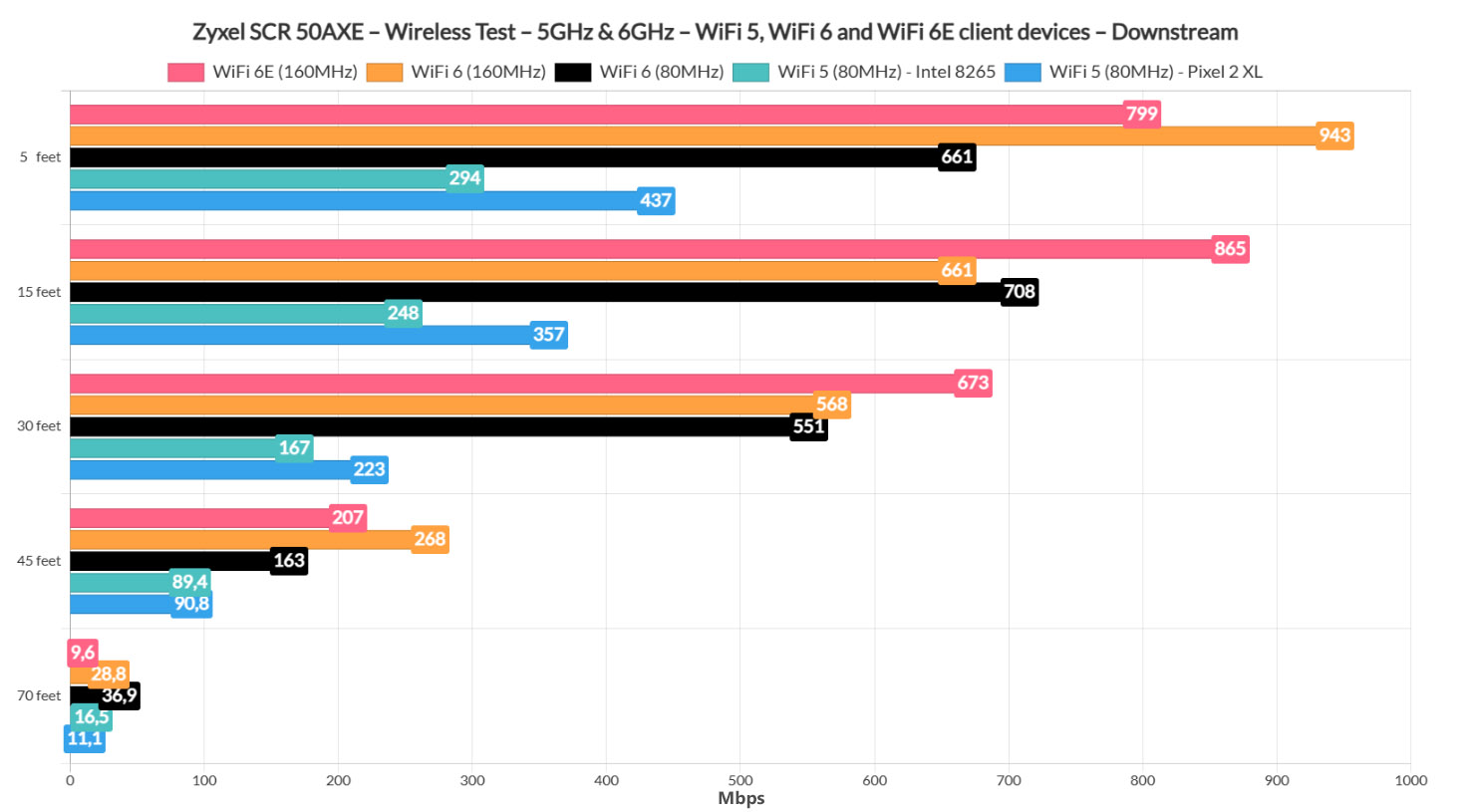
The Wireless Test (5GHz)
While the compatibility was set to 802.11ax-only, I checked out the wireless performance of the Zyxel SCR 50AXE when a WiFi 6 client device (AX200) was connected to the 5GHz network. The channel bandwidth was 80MHz, because I have been unsuccessful to switch it to 160MHz (kept getting this error: INVALID_RADIO_BAND50_CHANNEL_BANDWIDTH). That being said, at 5 feet, I measured an average of 795Mbps upstream and 661Mbps downstream, and I actually saw an even better throughput at 15 feet (despite the increased attenuation at -41dB).
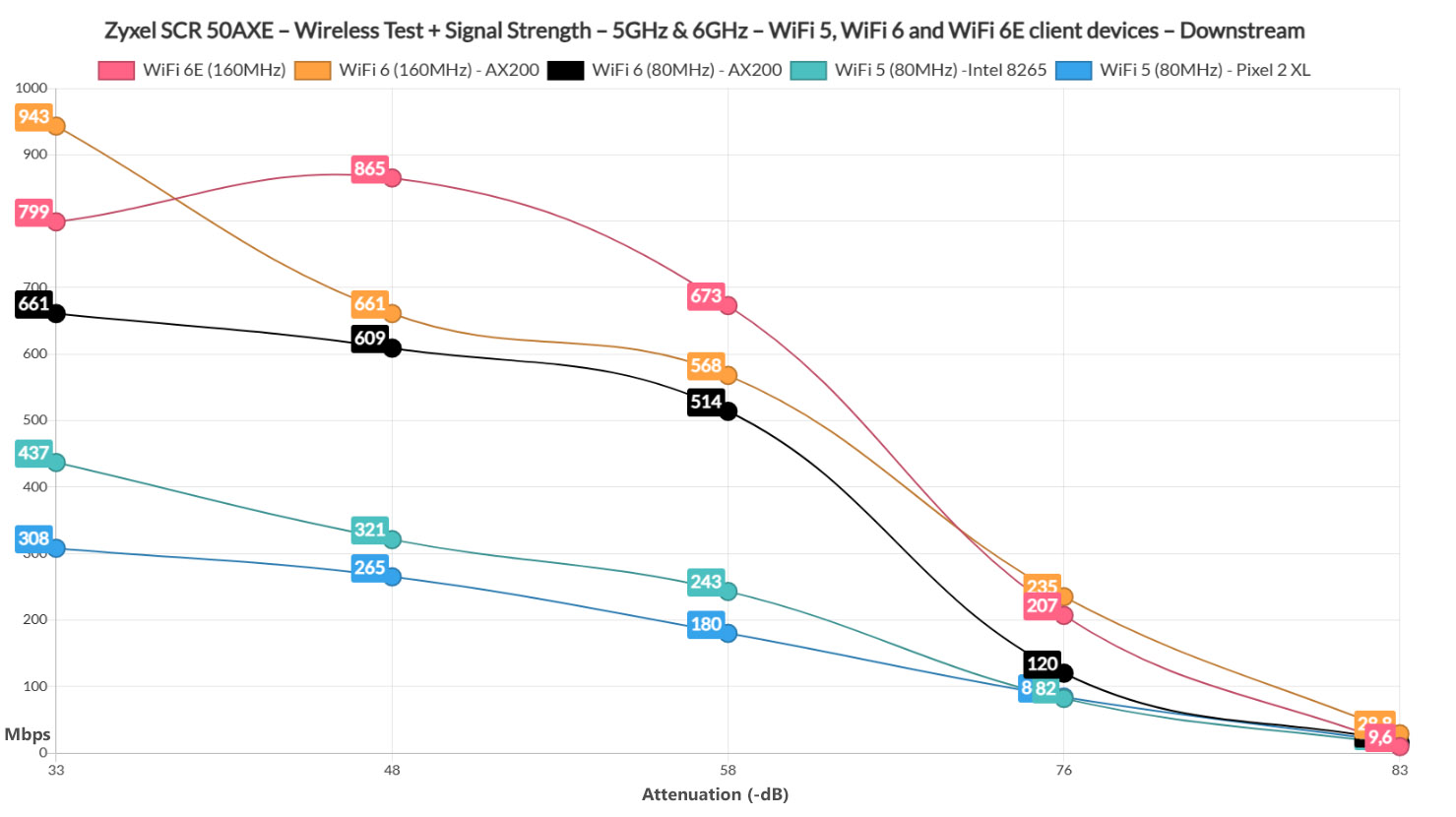
At 30 feet, the performance was still excellent: I saw an average of 618Mbps up and 545Mbps downstream (-54dB). But the biggest surprise came at 70 feet, where there was a -79dB attenuation, but upstream, I measured an average of 107Mbps, while downstream, it was 36.9Mbps. That’s an excellent range and coverage. Moving forward, I changed the compatibility mode in order to allow the two WiFi 5 client device to connect, the laptop equipped with an Intel 8265 adapter and the perpetual Pixel 2 XL (I think I am going to end up using it for another decade, despite its near comatose existence).
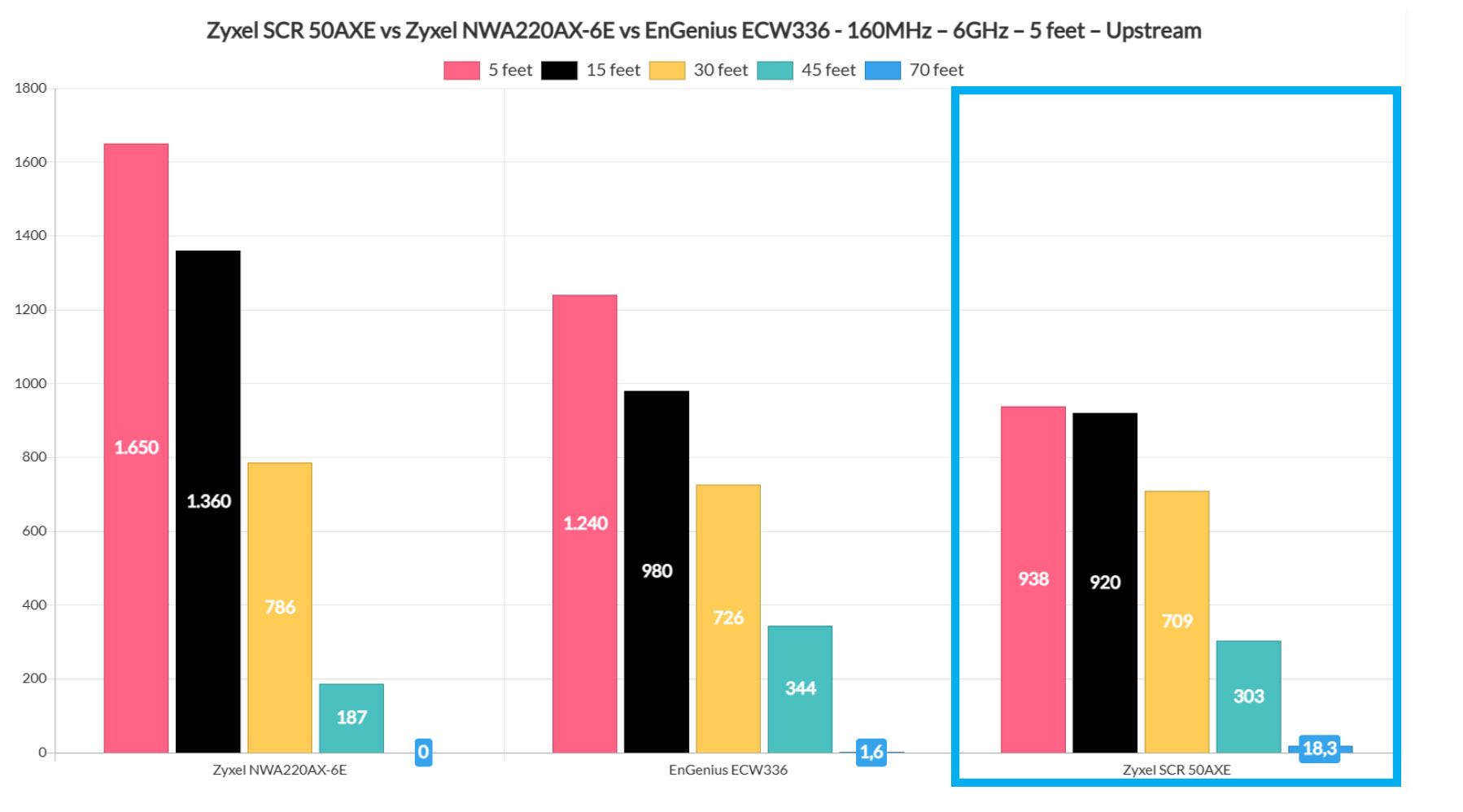
So, while the Intel 8265 WiFi 5 client device was connected to the 5GHz network (80MHz), I measured an average of 648Mbps upstream and 294Mbps downstream, both at 5 feet, while at 45 feet, it was 143Mbps up and 89.4Mbps downstream (-74dB). At 70 feet, you could still run some online software and applications considering that upstream, I measured an average of 41.8Mbps and downstream, I saw around 16.5Mbps. Moving to the Pixel 2 XL, it performed surprisingly well.
Zyxel SCR 50AXE
-Pros
- The 6GHz radio
- OFDMA
- Very good wireless performance across all three radio bands
- Security features
Cons
- I have experienced some weird issues when setting up the router
- The SSIDs would behave weird (despite being deleted, the main SSID still remained active)
- Gigabit limitation
- No local management tool

Mark is a graduate in Computer Science, having gathered valuable experience over the years working in IT as a programmer. Mark is also the main tech writer for MBReviews.com, covering not only his passion, the networking devices, but also other cool electronic gadgets that you may find useful for your every day life.

